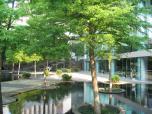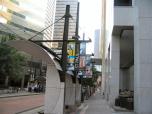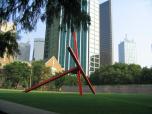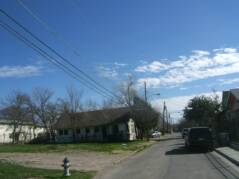




One of the sad facts of an economic downturn is the thousands of buildings that can sit empty and rundown in an urban area with few prospects for rehabilitation. In this current recession they are buildings that have been foreclosed upon or where the owner has simply walked away from the property. The usual byproducts of this include broken windows, rodent infestations, overgrown weeds and shrubbery, vagrants, fires, and increased crime. These problems then tend to negatively impact the surrounding area and subsequently neighboring property values fall, the visual appeal of the area declines, crime increases and community cohesion is marred.
The benefits of properties being renewed and refreshed include a newer and fresher façade, additional people added to the street life, increased revenues for the existing businesses in the area from the new residents and business people, additional property and sales taxes for the city, and ultimately a better quality of life in the neighborhood as it does not put forth the appearance of that of a jigsaw puzzle with missing pieces. Oftentimes, properties that lay empty and boarded up create a sense that the neighborhood is not a good investment.
One of the best examples in Dallas where an area was dramatically turned around and tremendously improved was in the Cityplace area of Uptown, along McKinney Avenue where West Village and surrounding development is today. This area was targeted, and steps for its renewal were put into place after the devastating recession of the late 1980’s, where numerous properties in Dallas lost more than 40% of their value.
Since its inception in 1992, the total investment in the Cityplace Area TIF District has been more than $506 million, encompassing over 2,674 residences and approximately 659,000 square feet of retail, commercial, and office space. Property value in the district has increased by 968.38% since the district’s inception. (City of Dallas Department of Economic Development)
You may not have the millions of dollars required to make a huge investment for the renewal of an area of Dallas. That does not mean however that you cannot have a role in improving something, getting rid of a problem that you don’t like, or making an investment in your community’s future. There are a number of programs existing on the local, state, and federal level that have the goal of improving properties and areas of town and assisting individuals and businesses who are committed in pursuing those goals.
The following is a list and description of a few of these programs that can be used in various communities in the Dallas-Fort Worth area.
Program Description
City of Dallas Regional Center (CDRC)
The CDRC is dedicated to assisting individuals and their families through the EB-5 immigration process via investment into businesses and development projects located within the Dallas city limits. The CDRC offers a variety of qualified investments to foreign investors that meet or exceed Program requirements, and offer investors features unique to the EB-5 community.
Economic Development Administration Grants Offered through the U.S. Housing and Urban Development Department.
Offered through the U.S. Housing and Urban Development Department.
These grants underwrite the cost of planning and construction for projects in rural and urban locations which may produce jobs for the community.
Enterprise Zones
The State of Texas allows cities and counties to designate geographic areas within their jurisdiction as State Enterprise Zones. These are economically distressed geographic areas within the city targeted for business development that will create jobs, stimulate further economic revitalization and reduce distress.
Enterprise Zone - Texas Incentives For qualified businesses investing in Enterprise Zones, the State offers a one-time state sales and use tax refund, a one-time franchise tax refund and preference for all programs administered by the State of Texas.
For qualified businesses investing in Enterprise Zones, the State offers a one-time state sales and use tax refund, a one-time franchise tax refund and preference for all programs administered by the State of Texas.
Federal Historic Preservation Tax Credit
The Federal Historic Preservation Tax Incentives program is one of the nation's most successful and cost-effective community revitalization programs. The program fosters private sector rehabilitation of historic buildings and promotes economic revitalization. The Federal program encourages businesses to take ownership and restore historic buildings for tax incentives.
The program is jointly managed by the National Park Service and the Internal Revenue Service, in partnership with State Historic Preservation Offices.
Property Tax Abatement
Texas allows local property taxing jurisdictions to partially or fully abate, for a maximum of ten years, a company's real and personal property taxes. Property tax abatement is limited by state law to new investment; property already on the tax roll is ineligible for abatement. An amount of up to 100% of the property’s appraised value from improvements begun after establishment of an agreement can apply.
Historically Underutilized Business Zones
The HUBZone Empowerment Contracting Program is operated by the U.S. Small Business Administration (SBA). This program stimulates economic development and creates jobs in urban and rural communities by providing Federal contracting preferences to small businesses. These preferences go to small businesses that obtain HUBZone certification.
A small business must meet all of the following criteria to qualify for the HUBZone program:
• maintain a "principal office" in a historically underutilized business zone;
maintain a "principal office" in a historically underutilized business zone;
• be owned and controlled by one or more U.S. citizens, and
be owned and controlled by one or more U.S. citizens, and
• at least 35% of its employees must reside in a HUBZone
at least 35% of its employees must reside in a HUBZone
SBA Loans
The proceeds of SBA Loans can be used for most business purposes. These may include the purchase of real estate for business operations; construction, renovation or leasehold improvements; acquisition of furniture, fixtures, machinery and equipment; purchase of inventory and working capital.
The Dallas/Fort Worth District Office is committed to fostering economic growth by providing assistance to small businesses that are located in its area of operation.
Skills Development Fund
The Texas Skills Development Fund (SDF) assists businesses and trade unions by financing the design and implementation of customized job training projects. The SDF program does not preclude the use of funds for literacy and adult education, if a business identifies this as a need. This fund successfully merges business needs and local customized training opportunities into a winning formula to increase the skills level and wages of the Texas workforce.
Businesses and trade unions must partner with an eligible applicant in order to be considered for Skills Development Fund grants. Eligible applicants are public community or technical colleges, the Texas Engineering Extension Service or a community-based organization working in partnership with one of these institutions. The average cost for a SDF trainee is approximately $1,000 (based on data from fiscal year 2005) with a standard length 12 month contract, although the actual cost can be higher or lower.
The Greenness of Rehabilitation
Posted: January 31, 2012 by Chuck DeShazo
